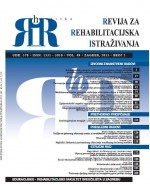Upitnik za određivanje razine intervencija/vođenje slučaja: Prijedlog normi/standarda procjene za Hrvatsku
The Youth level of service/case management inventory: Proposal of norms/assessment standards for Croatia
Author(s): Anja Mirosavljević, Nivex Koller-Trbović, Gabrijela Ratkajec GaševićSubject(s): Psychology
Published by: Sveučilište u Zagrebu, Edukacijsko-rehabilitacijski fakultet
Keywords: children and youth with nebaivioural problems; YLS/CMI; normative data for Croatia
Summary/Abstract: The main goal of this paper is focused on validation and standardization of the questionnaire Youth Level of Service/Case Management Inventory (YLS/CMI developed by Andrews & Leischied, 2002) on the sample of children and youth with behavioural problems in Croatia. The instrument was originally developed within the Canadian system while the assessment standards or norms were based on a sample of high and very high risk youth in conflict with the law. Therefore, its implementation and application requires adaptation to different cultural and social settings than the one where it was originated, and partly due to the different characteristics of the population of children and youth. The first version and adaptation of the original instrument into Croatian language was done in 1998 on the Faculty of Education and Rehabilitation Sciences University of Zagreb. Instrument was standardized in Croatia in 2002 (Nikolić, Koller-Trbović & Žižak, 2002). In the meantime, the original version of the instrument underwent minor changes, and after 10 years of the its application in Croatia, it was necessary to check the earlier norms. The sample was consisted of 647 of children and young people with behavioural problems, aged 12 to 18, who were at the time of the study involved in some form of treatment in Croatia (community, institutional or day treatment). The results showed strong metric characteristics of the questionnaire, and the overall risk scores normative data is proposed. Furthermore, in contrast to the standardization of the instrument in 2002, new norms are developed separately for girls and boys, as well as for the specific risks/needs areas
Journal: Hrvatska revija za rehabilitacijska istraživanja
- Issue Year: 49/2013
- Issue No: 2
- Page Range: 69-90
- Page Count: 22
- Language: Croatian

